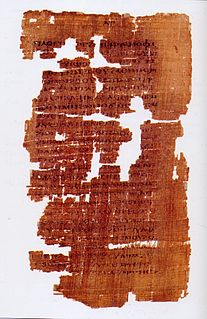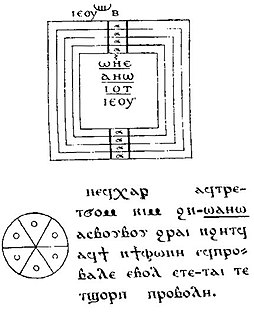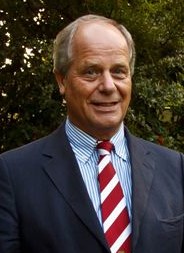Related Research Articles

Gnosticism is a collection of religious ideas and systems which originated in the late 1st century AD among Jewish and early Christian sects. These various groups emphasised personal spiritual knowledge (gnosis) above the orthodox teachings, traditions, and authority of traditional religious institutions. Viewing material existence as flawed or evil, Gnostic cosmogony generally presents a distinction between a supreme, hidden God and a malevolent lesser divinity who is responsible for creating the material universe. Gnostics considered the principal element of salvation to be direct knowledge of the supreme divinity in the form of mystical or esoteric insight. Many Gnostic texts deal not in concepts of sin and repentance, but with illusion and enlightenment.
The Nag Hammadi library is a collection of early Christian and Gnostic texts discovered near the Upper Egyptian town of Nag Hammadi in 1945.
The Gnostic Society is an organization founded in Los Angeles in 1928, and incorporated in 1939, by John Morgan Pryse (1863-1952) and his brother James Morgan Pryse (1859-1942) for studies of Gnosticism. Stephan A. Hoeller, author and lecturer and a leading exponent of Gnosticism as living religious practice, has been director of studies since 1963, and is also the Bishop of the Ecclesia Gnostica.
Valentinus was the best known and, for a time, most successful early Christian Gnostic theologian. He founded his school in Rome. According to Tertullian, Valentinus was a candidate for bishop but started his own group when another was chosen.

The Apocryphon of John, also called the Secret Book of John or the Secret Revelation of John, is a 2nd-century Sethian Gnostic Christian text of secret teachings. Since it was known to Irenaeus, a Church Father, it must have been written before 180 CE. It describes Jesus appearing and giving secret knowledge (gnosis) to John the Apostle. The author describes it having occurred after Jesus "has gone back to the place from which he came". The book is reputed to bear that revelation.

The Books of Jeu are two Gnostic texts. Though independent works, both the First Book of Jeu and the Second Book of Jeu appear, in Coptic, in the Bruce Codex.
The Sethians were one of the main currents of Gnosticism during the 2nd and 3rd century CE, along with Valentinianism and Basilideanism. According to John D. Turner, it originated in the 2nd-century CE as a fusion of two distinct Hellenistic Judaic philosophies and was influenced by Christianity and Middle Platonism. However, the exact origin of Sethianism is not properly understood.
Allogenes is a repertoire, or genre, of mystical Gnostic texts dating from the first half of the Third Century, CE. They concern Allogenes, "the Stranger", a half-human, half-divine capable of communicating with realms beyond the sense-perceptible world, into the unknowable.
The Teachings of Silvanus is one of the books found in the Nag Hammadi library. It is generally dated around 150. Two of the more interesting verses are 99.13, which states Christ has a single hypostasis and 102.3, which states Christ is incomprehensible with respect to his hypostasis.
Edwin Masao Yamauchi is a Japanese-American historian, (Protestant) Christian apologist, editor and academic. He is Professor Emeritus of History at Miami University, where he taught from 1969 until 2005. He is married to Kimie Honda.
Gnosticism in modern times includes a variety of contemporary religious movements, stemming from Gnostic ideas and systems from ancient Roman society. Gnosticism is an ancient name for a variety of religious ideas and systems, originating in Jewish-Christian milieux in the first and second century CE.
Gilles Quispel was a Dutch theologian and historian of Christianity and Gnosticism. He was professor of early Christian history at Utrecht University.
James McConkey Robinson was an American scholar who retired as Professor Emeritus of Religion at Claremont Graduate University, Claremont, California, specializing in New Testament Studies and Nag Hammadi Studies. He was a member of the Jesus Seminar and arguably the most prominent Q and Nag Hammadi library scholar of the twentieth century. He was also a major contributor to The International Q Project, acting as an editor for most of their publications. Particularly, he laid the groundwork for John S. Kloppenborg's foundational work into the compositional history of Q, by arguing its genre as an ancient wisdom collection.
John D. Turner was the Cotner Professor of Religious Studies and Charles J. Mach University Professor of Classics and History Classics & Religious Studies at the University of Nebraska. He was well known for his translations of the Nag Hammadi library.
The Manichaean Psalter is a Manichaean text written in Coptic. It is believed to have been compiled in the late 3rd century or the mid-4th century. The Psalter is believed to contain remnants of some of the earliest extant Manichaean literature.
Marvin W. Meyer was a scholar of religion and a tenured professor at Chapman University, in Orange, California.
April D. DeConick is the Isla Carroll and Percy E. Turner Professor of New Testament and Early Christianity at Rice University in Houston, Texas. She came to Rice University as a full professor in 2006, after receiving tenure at Illinois Wesleyan University in 2004. DeConick is the author of several books in the field of Early Christian Studies and is best known for her work on the Gospel of Thomas and ancient Gnosticism.
Pheme Perkins is a Professor of Theology at Boston College, where she has been teaching since 1972. She is a nationally recognized expert on the Greco-Roman cultural setting of early Christianity, as well as the Pauline Epistles and Gnosticism.

Johannes (Hans) van Oort is a Dutch academic who is the Professor of Patristics and Gnostic Studies at Radboud University, Nijmegen, and at the University of Pretoria, South Africa. He is best known for his specialty in the study of St. Augustine, the gnostic world religion of Mani (Manicheism), and the Gospel of Judas. In 2006 van Oort presented, with the National Geographic Society, the discovery of this gnostic “gospel” to the Dutch speaking world.
Nicola Denzey Lewis is a Canadian academic of lived religion, early Christians, material culture of late antique Roman Empire, and women studies. She is a professor at Claremont Graduate University as the Margo L. Goldsworth Chair in Women's Studies in Religion.
References
- ↑ veritas-ucsb Curriculum Vitae
- ↑ "Honorary Doctors of the Faculty of Theology - Uppsala University, Sweden". www.uu.se (in Swedish). Retrieved 2017-02-17.
- ↑ Conick, April (2013). Practicing gnosis: ritual, magic, theurgy and liturgy in Nag Hammadi, Manichaean and other ancient literature: essays in honor of Birger A. Pearson. Leiden: Brill. ISBN 978-90-04-24852-6. OCLC 852968014.